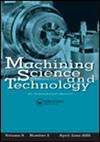基于多传感器信号的线材电火花加工过程性能监测与故障预测系统
IF 2.6
4区 工程技术
Q2 ENGINEERING, MANUFACTURING
引用次数: 6
摘要
摘要本研究旨在开发一种基于放电脉冲特性的脉冲分类算法,以了解线电火花加工过程的稳定性和性能。此外,还提出了一种过程数据驱动的故障预测系统。电火花线切割监测系统包括高采样率差分探针和电流探针。通过脉冲串分析提取的特征是火花放电能量、点火延迟时间、火花频率和各种放电的比例。提出了一种脉冲识别算法,将放电分为开路放电、电弧放电、短路放电和正常放电。观察到,较高比例的短路脉冲导致较差的零件质量。基于提取的特征,研究了稳定和不稳定加工过程中脉冲周期的差异。研究发现,在导线断裂之前,放电频率以及电弧和短路脉冲的比例都非常高。开发了一个人工神经网络(ANN)模型,从工艺数据中预测工艺响应,如切削速度和表面粗糙度。此外,基于提取的加工过程数据,开发了一种智能算法来预测导致加工故障的不稳定条件。通过进行验证测试,证实了该算法的准确性非常高。本文章由计算机程序翻译,如有差异,请以英文原文为准。
Performance monitoring and failure prediction system for wire electric discharge machining process through multiple sensor signals
Abstract This study aims to develop a pulse classification algorithm to understand wire electric discharge machining (wire EDM) process stability and performance based on the discharge pulse characteristics. Also, a process data driven failure prediction system is proposed. The wire EDM monitoring system includes high sampling rate differential probes and current probes. The features extracted through pulse train analysis were spark discharge energy, ignition delay time, spark frequency and proportion of various discharges. A pulse discrimination algorithm was proposed, which classifies the discharges into open circuit sparks, arc discharges, short circuit sparks and normal sparks. It was observed that higher proportions of short circuit pulses resulted in inferior part quality. The differences in the pulse cycle during stable and unstable machining were studied based on the extracted features. It was found that the discharge frequency and the proportion of arc and short circuit pulses were extremely high before the wire breakages. An artificial neural network (ANN) model was developed to predict the process responses, like cutting speed and surface roughness, from the process data. Also, an intelligent algorithm was developed based on the extracted in-process data to predict the unstable conditions, leading to machining failures. The accuracy of the algorithm was confirmed to be very high by conducting confirmation tests.
求助全文
通过发布文献求助,成功后即可免费获取论文全文。
去求助
来源期刊

Machining Science and Technology
工程技术-材料科学:综合
CiteScore
5.70
自引率
3.70%
发文量
18
审稿时长
6 months
期刊介绍:
Machining Science and Technology publishes original scientific and technical papers and review articles on topics related to traditional and nontraditional machining processes performed on all materials—metals and advanced alloys, polymers, ceramics, composites, and biomaterials.
Topics covered include:
-machining performance of all materials, including lightweight materials-
coated and special cutting tools: design and machining performance evaluation-
predictive models for machining performance and optimization, including machining dynamics-
measurement and analysis of machined surfaces-
sustainable machining: dry, near-dry, or Minimum Quantity Lubrication (MQL) and cryogenic machining processes
precision and micro/nano machining-
design and implementation of in-process sensors for monitoring and control of machining performance-
surface integrity in machining processes, including detection and characterization of machining damage-
new and advanced abrasive machining processes: design and performance analysis-
cutting fluids and special coolants/lubricants-
nontraditional and hybrid machining processes, including EDM, ECM, laser and plasma-assisted machining, waterjet and abrasive waterjet machining
 求助内容:
求助内容: 应助结果提醒方式:
应助结果提醒方式:


